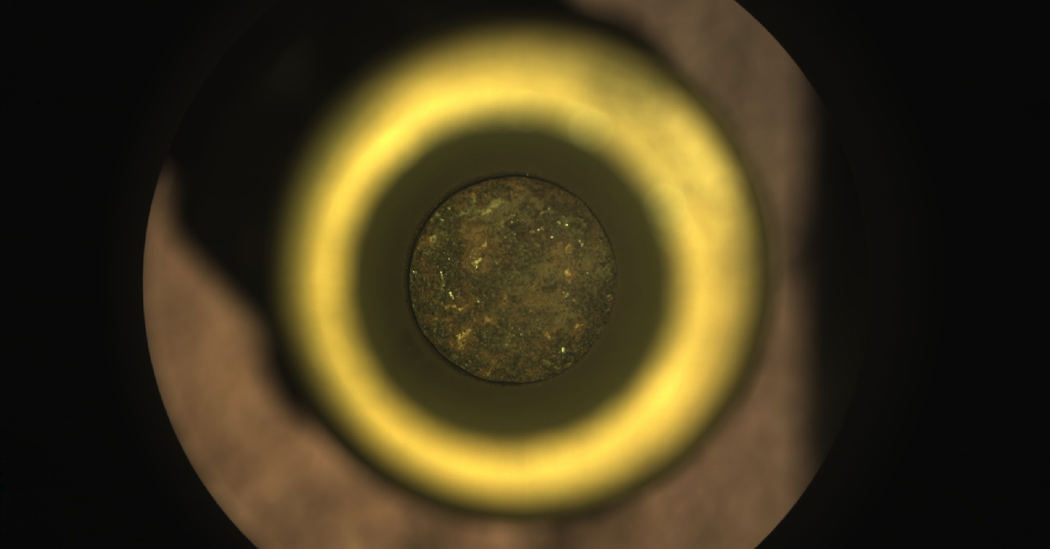

NASA’s Perseverance rover on Mars has confirmed the successful collection of its first rock sample.
“One down, a lot more to go!” Kenneth A. Farley, professor of geochemistry at the California Institute of Technology and the mission’s project scientist, said in an email.
On Monday night, NASA announced that the rover had sealed the tube that contains the rock core, which is slightly thicker than a pencil, and put it away for safekeeping in its belly. That and other collected samples will be dropped to the ground to be collected by another spacecraft. They will eventually be ferried back to Earth, helping scientists study the mysteries of the red planet in much the same way that lunar samples from the Apollo and Soviet missions helped advance understanding of the moon.
For decades, planetary geologists have wanted to study rocks from another planet. They have done that with pieces of Mars that were blasted into space by meteor impacts and later passed Earth’s path and landed as meteorites. But with Martian meteorites, scientists had no idea where the rocks originated — intriguing pieces from a jigsaw puzzle but no opportunity to find the other pieces.
With the Perseverance samples, scientists will know exactly which rocks the samples came from, and the rover will have performed detailed study of the surrounding geology.
The rover drilled the core from a flat, briefcase-size Mars rock nicknamed Rochette last week. In the first pictures that the rover took of the collection tube, the rock sample could be easily seen.
But viewers on Earth were concerned when the rock couldn’t be seen in subsequent photographs. Those were taken after Perseverance used its robotic arm to shake the tube to help the sample settle to the bottom of the container. Mission managers were confident it was just hidden in shadow, but after a failed drilling attempt last month, they wanted to make sure before sealing the tube.
Subsequent photographs with better lighting showed the rock was still there.
Rochette looks to be a piece of a hardened lava, which can be precisely dated. Thus, scientists will be able to determine how old this boulder is, and it helps pin down the ages of lower, older layers.
In the first drilling attempt in August, everything on Perseverance appeared to function flawlessly yet the tube ended up empty. Analyzing what happened, scientists and engineers working on the mission concluded that the first rock was just too fragile and the sample fell out.
One of the key tasks for Perseverance, which arrived on Mars in February, is to collect rocks and soil that will eventually be brought back to Earth by another mission so that scientists can exhaustively study them using state-of-the-art instruments in their laboratories. Scientists hope to collect more than 30 samples from a variety of locations in Jezero crater, a landing site that was chosen because scientists on Earth felt an ancient river delta along the crater rim was a promising target for fossilized microbial life if it ever existed.
Perseverance is collecting the rock and soil samples but has no way to deliver them back to Earth. That will await the future mission, which is still being designed.
On Saturday, Ingenuity, the robotic helicopter accompanying Perseverance, made its 13th flight, scouting a series of outcrops to provide help in planning upcoming drives by the rover.
24World Media does not take any responsibility of the information you see on this page. The content this page contains is from independent third-party content provider. If you have any concerns regarding the content, please free to write us here: contact@24worldmedia.com

Common Mistakes When Using Athletic Field Tarps

High-Performance Diesel Truck Upgrades You Should Consider

Warehouse Optimization Tips To Improve Performance

Fire Hazards in Daily Life: The Most Common Ignition Sources

Yellowstone’s Wolves: A Debate Over Their Role in the Park’s Ecosystem

Earth Day 2024: A Look at 3 Places Adapting Quickly to Fight Climate Change

Millions of Girls in Africa Will Miss HPV Shots After Merck Production Problem

This Lava Tube in Saudi Arabia Has Been a Human Refuge for 7,000 Years

Four Wild Ways to Save the Koala (That Just Might Work)

National Academy Asks Court to Strip Sackler Name From Endowment

Ways Industrial Copper Helps Energy Production

The Ins and Out of Industrial Conveyor Belts